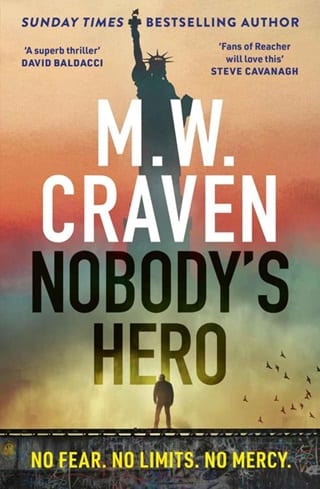Chapter 67
Chapter 67
Koenig fixed himself a pot of coffee, then figured out how to wirelessly connect the laptop to the printer. He printed hard copies of every photograph in the reports. There were 164 in total. He had to refill the printer’s ink twice. He then printed a bunch of documents.
When he was done, he gathered the untidy stack and carried it to the conference table. Instead of sorting them into three case-related piles, he arranged them in evidence types. When you’re looking for connections, you don’t look at things in isolation; you look at them together.
He started with where the bodies were found – Oregon, Maine and New Jersey. Oregon was in the Pacific Northwest. Maine was in New England. Neither state had flourishing organised crime, certainly nothing big enough to collaborate across the three thousand miles that separated them. New Jersey did have organised crime, but their collaborations and feuds tended to be with New York, Chicago and Philly. Sometimes Boston and Pittsburgh. Koenig shuffled the location pile together and set it to one side.
He moved on to the victim biographies. Where they lived. What they did for a living. What they got up to in their spare time. That kind of thing. Louise Durose had been a sanitation engineer with an expertise in landfill management. Hank Reynolds worked in cybersecurity. Michael Gibbs had something to do with deepwater port productivity. Important jobs, but not the kind of thing that got you murdered. He jotted down a note to find out exactly what Reynolds’s work had entailed. Cybersecurity was Draper’s area of expertise, not his.
The photographs taken at the scene were next. All 164 of them. Most were of Louise Durose and the man she’d been with. Homicides generated more paperwork than suicides and accidents. The CSI guys had photographed the bodies, the alley they’d been found in, the murder weapon. They’d documented the blood spatter on the walls and the alley debris. The empty liquor bottles, the cigarette butts, the broken glass. They’d gone to her hotel room and photographed her possessions.
Koenig reread the autopsy reports. He flicked through the cause-of-death sections. Cause of death was never as useful as the movies made out. Pathologists rarely provided the golden bullet. Their role was mainly confirming what the cops already suspected, and gathering the evidence that would convict the perpetrator. Cause of death was about facts. It was black and white. It was manner of death that was interesting. Manner of death wasn’t black and white. It fooled around in the grey areas. Cause of death was the specific injury that began a lethal chain of events that resulted in death. Manner of death was how the injury happened. Cerebral hypoxia, where the brain is cut off from its supply of oxygen, caused the death of Hank Reynolds. The manner of his death was that he was hanged.
If you knew what pathologists looked for, it was possible to stage a hanging. Koenig hadn’t seen it for himself, but he’d once spoken to a detective who had. The sergeant, a barrel-chested Irishman from Boston, was called to a suicide. A woman had jumped through her loft hatch with a towrope around her neck. The detective said he only caught it as the drop was long enough to have snapped the woman’s neck. Instead, she’d died by strangulation. They’d arrested the victim’s brother, and he eventually admitted to lying in wait in the loft, slipping the noose over her head, then yanking her up like the rope was a spring-loaded snare.
A staged hanging was an overly elaborate way of disguising a murder, though. There were easier ways to stage a suicide. Disposing of the victim, then leaving their car and clothes at the beach. Forcing a gun into their mouth and blowing the back of their head off. Pushing them off a cliff and claiming they jumped. Koenig thought the investigating cops had gotten it right. He thought Hank Reynolds had hanged himself.
It was more likely they’d got it wrong with Michael Gibbs. The lack of skid marks on Park Loop Road meant they should have at least considered suicide. Yes, Gibbs had just eaten a heavy meal, but he wasn’t a six-week-old puppy. Food didn’t immediately send healthy adults to sleep. Excessive alcohol, maybe, but not food. And the extravagant feast Gibbs had spent a small fortune on did have the whiff of a last meal. A blowout before he pulled the plug.
Potentially two suicides then.
Louise Durose hadn’t killed herself, though. She’d had her face smashed in with a brick. Koenig wasn’t convinced by the death-by-pimp conclusion the responding New Jersey cops had jumped to. He thought it was a lazy reach. But regardless of who’d wielded the brick, Durose had been murdered. The homicide cops were working it hard. They were taking it seriously. They’d canvassed for witnesses. They’d studied thousands of hours of CCTV footage. They’d spent most of their annual budget on lab tests. They’d even done a reconstruction. Nothing. Not a thing. It was as if Louise Durose had been alive and then dead, and the world had missed the bit in the middle.
There was only one, probably easily explained, chink in the armour of Koenig’s mugging-gone-wrong theory: the Van Gogh’s Chair print in Durose’s hotel room. The maid had reported it missing. Koenig studied the CSI photograph, and if you knew the print was supposed to be there, you did notice the slightly darker rectangle of paint. A patch the sun hadn’t gotten to. A New Jersey detective had taken the hotel manager’s statement. He’d explained that the hotel bought the prints in bulk from a company that specialised in supplying artwork to the hospitality sector. They’d cost three bucks a unit.
Still, Durose hadn’t checked out, and the print wasn’t found in her luggage or her rental. Unless the guest before her had taken it, it was a mystery. One that would likely never be solved. Certainly not by the New Jersey homicide unit. They had NFA’d it. No further action.
Koenig poured himself a fresh coffee. The cups on the plane were bone china. Thin as paper. Nothing so crass as mugs with corporate logos for Draper.
He found an image of Van Gogh’s Chair on a website about Postimpressionists. He’d never really appreciated art. Had always felt undereducated in the company of people who did.
At first glance, Van Gogh’s Chair looked like any other still life. A ratty yellow chair and a box of onions. Pale blue walls and a dark blue door. Terracotta tiles on the floor. Famous because of who had painted it. No narrative. Nothing to see that hadn’t been painted. But as he read how Van Gogh had painted it just before his breakdown, how he’d used it to send a coded message to his one-time friend, the French Symbolist Paul Gauguin, he saw what Van Gogh had been trying to say. That every item on the canvas was a story about Van Gogh’s life. About his philosophy. His hopes and his fears. The despair he felt as his friendship with Gauguin disintegrated.
None of that explained why Durose had stolen the print, though. It had no monetary value. If she’d taken a fancy to it, better-quality prints could be ordered almost anywhere.
Koenig sighed. He rubbed his eyes and rolled his shoulders, as his body reminded him he wasn’t as young as he used to be. He didn’t want to go to sleep, though. Not until he’d exhausted everything. Turned over every stone.
The printer whirred. Draper must have been printing something from her laptop. Koenig waited for the document to appear, but all that happened was the out of ink light flashed. Again. Koenig opened the cupboard and pulled out another box of ink cartridges. He slotted in the cyan. He slotted in the magenta.
But when it came to the yellow cartridge, he paused.
He turned the ink cartridge over in his hand and studied it. He didn’t know why, but the part of his brain that worked silently in the background was trying to grab his attention. Higher-order thinking, he thought it was called. And HOT went beyond memorising facts. HOT asked the brain to do something with those facts. Things like idea generation and critical thinking. Problem solving and big picture visualisation.
Making connections.
And right now, Koenig’s higher-order thinking was telling him the ink cartridge was important. That it would help him understand what was happening. Maybe not the cartridge exactly. But something to do with the cartridge. A feature of the cartridge that was present in all three deaths.
Koenig cleared away all but a dozen of the CSI photographs. He pored over them until his eyes began to blur. He rearranged them. He added photographs and he took others away. He rocked back on his heels and took them all in at once. He crouched over the table and studied each photograph individually.
He couldn’t see anything. There was nothing there.
Except that wasn’t quite right. There was something in one of the photographs. Something that wasn’t in any of the others. And it should have been. It was a smiley-face air freshener. It was in the photograph taken when Michael Gibbs had driven his wife’s station wagon into the parking lot at La Terrasse, the restaurant in Maine. The restaurant recorded all cars as they entered in case there was a malicious valet-parking claim later. Company policy. The smiley face was hanging from the rearview mirror’s mounting bracket. All yellow and happy. But it wasn’t in the photographs taken at the bottom of the ravine.
Which was strange.
What had happened to it? Had the elastic string snapped? In Koenig’s experience, the string on air fresheners was thin but durable. And if it had snapped, where was it? It wasn’t in the station wagon’s interior. He supposed it could have snapped and been tossed out as the station wagon bounced down the ravine, but that seemed unlikely.
Had Gibbs removed it before he headed home? Had he gotten sick of an air freshener that had run its course? Koenig thought back to the time when he’d owned a vehicle. He’d never bought an air freshener, but auto dealers always had new ones in their cars, and all his personal cars had had air fresheners. And he’d never thrown one out. Not once. Throwing out an air freshener seemed like more effort than leaving it there. He figured if he were ever going to throw one out, it would be if he’d bought a replacement. A like-for-like, one-in, one-out kinda deal.
He picked up the photograph with the smiley face. Held it next to the ink cartridge. Saw what it was that connected them. And then, like a Magic Eye picture coming into focus, everything dissolved until all that remained was the answer.
The answer to what was there.
And what wasn’t there.
He picked up a satellite phone. While he waited for it to power up, he searched for the telephone number he needed. When the light turned green, Koenig tapped in the number for the Gobblers Knob Hotel in Coos County, Oregon. It was answered immediately.
‘Can you put me through to housekeeping?’ he said.
 Fullepub
Fullepub 



